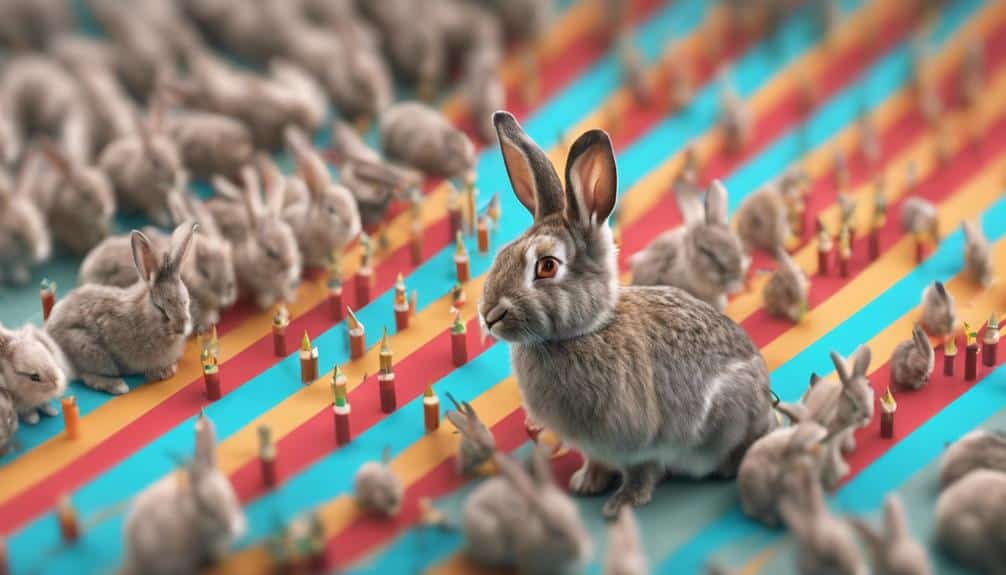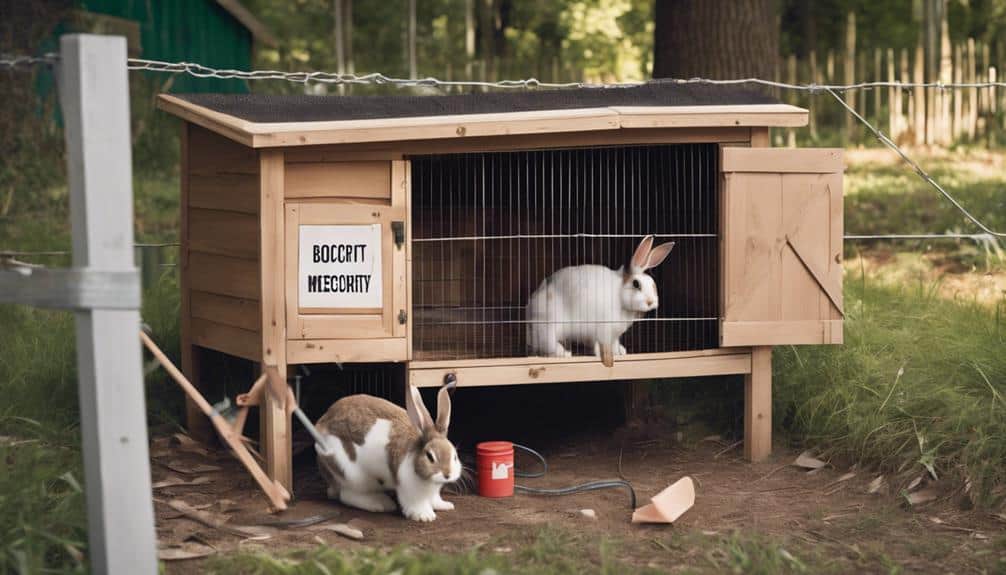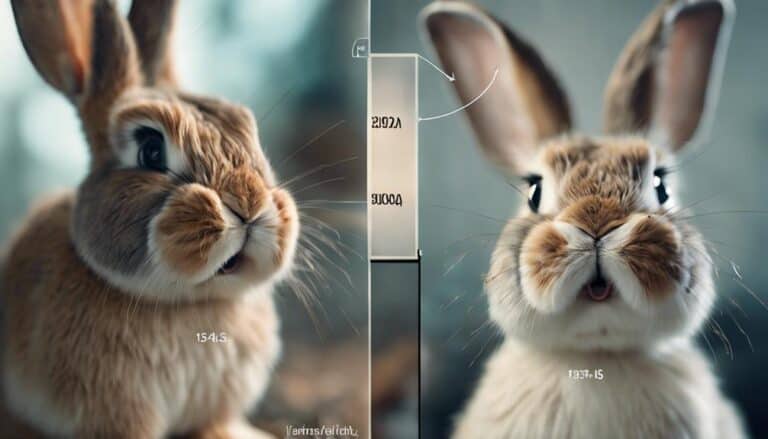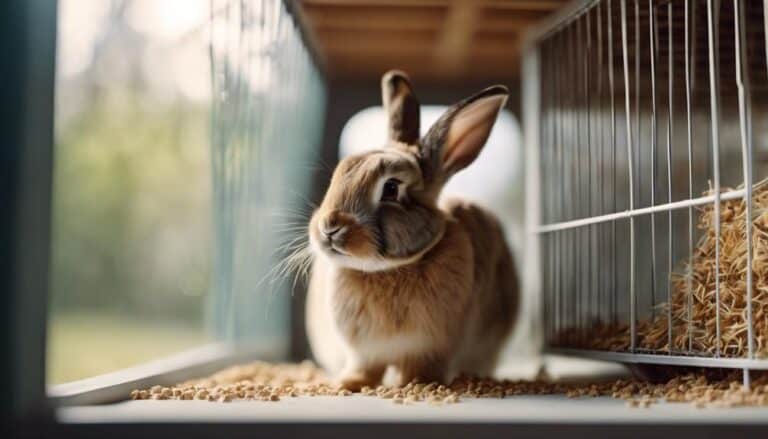To understand how Rabbit Hemorrhagic Disease spreads, just know that it can pass from rabbit to rabbit or through things they touch. When domestic rabbits hang out with wild ones, the risk of spreading the disease goes up. Even rabbits who survive the disease can carry it without knowing. That's why veterinarians play a big role in containing it early on. By using biosecurity measures and giving vaccinations, we can slow down how fast it spreads.
It's super important to keep an eye out for sudden rabbit deaths and act fast. Working together with different agencies to watch and manage the disease is key. By keeping track of the virus, making sure our places are secure, and reacting quickly, we can make a big difference. By studying how the disease spreads, seeing how well biosecurity measures work, figuring out the best ways to watch for it, and planning for the future, we can learn even more.
Contents
Key Takeaways
Rabbit Hemorrhagic Disease (RHD) can spread through direct and indirect contact between rabbits. This means that close contact or even sharing of spaces can help the virus move from one rabbit to another.
When it comes to preventing RHD spread, things like biosecurity measures and vaccinations play a big role. By keeping rabbits safe and vaccinated, we can reduce the chances of the virus spreading further. In addition to vaccinations, implementing proper biosecurity measures, such as isolating new rabbits and cleaning habitats regularly, is essential. Providing a nutritious diet that includes the best leafy greens for rabbits can also help boost their immune systems, making them less susceptible to infections. By fostering a healthy environment and diet, we can create a protective barrier against the spread of RHD and promote the well-being of domestic rabbit populations.
Surveillance is important in keeping an eye on RHD outbreaks. It helps us monitor how the virus is moving and allows us to take steps to slow it down.
In case of an outbreak, quick reporting and coordinated responses are crucial. The faster we act, the better chance we have of containing the virus and protecting more rabbits.
Collaboration among different agencies is key in managing RHD effectively. By working together, we can share resources and information to tackle the disease more efficiently.
Understanding RHDV-2 Transmission Patterns

Understanding how RHDV-2 spreads is crucial for controlling its impact on rabbits. This highly contagious virus can pass from infected to healthy rabbits through direct contact. It can also spread indirectly through contaminated objects, fur, or meat. This indirect transmission is risky, especially when domestic and wild rabbits share the same environment.
RHDV-2 has been found in both domestic and wild rabbit populations in various places, including several U.S. states and other countries. Rabbits that survive exposure to RHDV-2 can become carriers of the virus without knowing it, which can further spread the disease in their communities.
Veterinarians are key in spotting and reporting potential cases of RHDV-2 early. This helps in containing and reducing the spread of the virus quickly, protecting both domestic and wild rabbits from the harmful effects of this infectious disease.
Factors Influencing RHDV-2 Spread
Factors that affect how RHDV-2 spreads include how it's passed on through direct and indirect contact, how well biosecurity measures work, and how much vaccines help reduce cases in pet rabbits.
RHDV-2 has quickly spread to 28 U.S. states, 19 Mexican states, and 4 Canadian provinces, showing the need for important prevention steps. The virus can spread in different ways, which is why it causes a high number of deaths in rabbits. Despite the challenges of RHDV-2, efforts like biosecurity measures and vaccination programs have shown they can help lessen its impact.
For example, Texas has seen RHDV-2 move eastward in wild rabbits, with cases confirmed in many counties. This highlights the need for quick action to stop the virus from spreading further. Research and work to develop better vaccines are crucial in helping us understand the virus more and create vaccines that work better to fight its harmful effects.
Impact of Biosecurity Measures on Spread

Biosecurity measures like controlling access to rabbits, disinfecting equipment, and avoiding contact with wild rabbits have been crucial in reducing RHDV-2 cases in domestic rabbits. These protocols help limit the virus's spread effectively. Vaccination efforts have also played a significant role in controlling the disease. Veterinarians are key in this effort by being alert to sudden rabbit deaths and reporting any suspicious illnesses promptly. Given RHDV-2's high mortality rate, these proactive steps are vital for safeguarding rabbit populations.
The virus spreads through direct and indirect contact, underscoring the importance of biosecurity practices in preventing outbreaks. As RHDV-2 spreads to new areas like the eastern U.S. from Texas, maintaining strict biosecurity measures is essential to protect rabbits from this deadly disease.
Surveillance Strategies for RHDV-2
Surveillance strategies for RHDV-2 are super important in keeping an eye on how the virus spreads among both pet and wild rabbits. Since RHDV-2 has been found in lots of states and provinces, it's crucial to have effective surveillance in place. Things like biosecurity measures and vaccination efforts have really helped in slowing down the spread of RHDV-2 in pet rabbits. This shows us how important it's to keep a close watch on things.
Medgene Labs getting emergency approval for their RHDV-2 vaccine has been a big help in fighting the disease. The vaccine is becoming more available in different areas, which is great news. Veterinarians should think about RHDV-2 when they see sudden rabbit deaths, so we can catch it quickly and take action. RHDV-2 has a high death rate, so it's urgent that we keep researching better ways to diagnose it and make more vaccines.
We're also looking into how survivors might still carry the virus, so it's clear that surveillance and research are key to managing RHDV-2. It's all about staying on top of things and working together to stop the virus from spreading further.
Future Directions in Controlling Spread

To control the spread of Rabbit Hemorrhagic Disease Virus 2 (RHDV-2) better, we need to work together more. Federal and State agencies should team up for thorough monitoring and management. Keep an eye on how much RHDV-2 is in wild rabbit populations to see where it's going and if our containment efforts are working. It's crucial to report outbreaks quickly and coordinate our responses.
We must also make sure to have strict biosecurity measures and vaccination programs in place. This will help stop RHDV-2 from spreading among wild animals. By keeping a close watch on wild populations, we can catch RHDV-2 early and prevent it from spreading further. The National Wildlife Disease Program, along with agencies across the country, is key to managing and reducing the spread of RHDV-2 with proven strategies.
Frequently Asked Questions
How Does Rabbit Hemorrhagic Disease Spread?
Rabbit Hemorrhagic Disease spreads through body fluids and contaminated objects, like when infected rabbits sneeze, poop, or pee. Even flies and mosquitoes can carry the virus from one rabbit to another. So, it's not just direct contact that spreads it.
The virus can hang out on surfaces, waiting for another rabbit to touch or sniff around, which makes it super easy for the disease to spread quickly. To stop it, we gotta be careful about what our rabbits come into contact with, and also keep an eye out for pesky insects that can carry the virus around.
How Is Hemorrhagic Disease Spread?
Hemorrhagic disease can be spread through different ways like body fluids and contaminated surfaces. This means that you can catch it from things like blood, saliva, or even objects that have been in contact with the virus. The time it takes for symptoms to show up, called the incubation period, is a concern because it can be influenced by things in the environment and the ability of the virus to jump between different animal species.
To control the spread of hemorrhagic disease, it's important to have a strong immune response. This means that your body can fight off the virus more effectively. There are also animals that can carry the virus without showing symptoms, so identifying and managing these carrier animals is crucial. Vaccination is another key tool in preventing the spread of the disease, especially on a global scale.
In order to effectively manage the global spread of hemorrhagic disease, surveillance is essential. This means keeping a close eye on where the disease is popping up and how it's spreading. By monitoring and tracking the virus, we can take steps to contain it and prevent further outbreaks.
How Is Viral Haemorrhagic Disease Transmitted in Rabbits?
To figure out how viral hemorrhagic disease spreads in rabbits, we need to look at how it moves between rabbits, how likely rabbits are to get sick, and what factors in the environment help it spread. To stop it from spreading, we need to come up with ways to vaccinate rabbits and keep an eye out for the disease. The way the immune system responds and how the virus changes over time are important in controlling big outbreaks and when it jumps to different species.
Can RHDV2 Spread to Humans?
Can RHDV2 spread to humans? No, RHDV2 only affects rabbits and hares. It doesn't jump to people, so there's no need to worry about it affecting public health. Knowing how it spreads is important for keeping the disease in check.
Conclusion
So, it's really important to understand how Rabbit Hemorrhagic Disease Virus 2 (RHDV-2) spreads and what factors influence its transmission. This knowledge helps us put in place better biosecurity measures and surveillance strategies.
By studying the data and research findings, we can pinpoint where we need to focus our efforts to control the spread of the virus.
Moving forward, we'll need to keep researching and taking proactive steps to stop RHDV-2 from spreading and to keep rabbits safe from this deadly disease.






